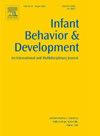Differing patterns of face processing in infants at elevated likelihood of autism
IF 2
3区 心理学
Q3 PSYCHOLOGY, DEVELOPMENTAL
引用次数: 0
Abstract
Typical development shows early biases in face attention during infancy, characterized by face inversion effects and increased attention to the left side of the face. In autism spectrum disorder (ASD), face scanning patterns often differ, with reduced inversion effects and left-side biases. The current study examined inversion effects, side biases, and pupil responses in EL and TL infants at 7, 10, and 13 months using linear mixed modeling. TL infants showed greater looking to the left side of the face than EL infants both over the full trial duration and in the 500–1000 ms trial window. Also, in the 500–1000 ms window, a significant left versus right side difference was observed only in the TL group. Pupil responses revealed an interaction between group and age, with EL infants showing a larger pupil size increase over time. These findings suggest that elevated ASD likelihood may be linked to early face-processing differences, such as reduced left gaze bias and greater pupil increases in infancy. Further research is necessary to determine if these patterns are specific to faces or reflect broader atypicalities in hemispheric asymmetry and autonomic function, and how these differences may contribute to later emerging features of ASD.
婴儿面部处理的不同模式增加了自闭症的可能性
典型的发育表现为婴儿期面部注意力的早期偏差,其特征是面部倒置效应和对左侧面部的注意力增加。在自闭症谱系障碍(ASD)中,面部扫描模式通常不同,倒置效应和左侧偏倚减少。目前的研究使用线性混合模型检查了7、10和13个月时EL和TL婴儿的反转效应、副作用和瞳孔反应。在整个试验期间和500-1000毫秒的试验窗口内,TL组婴儿比EL组婴儿更倾向于看脸左侧。此外,在500-1000 ms窗口,只有在TL组中观察到显著的左右侧差异。瞳孔反应揭示了群体和年龄之间的相互作用,随着时间的推移,EL婴儿的瞳孔尺寸增加得更大。这些发现表明,自闭症谱系障碍的可能性升高可能与早期面部处理差异有关,比如婴儿时期左凝视偏倚减少和瞳孔增大。需要进一步的研究来确定这些模式是脸部特有的,还是反映了半球不对称和自主神经功能的更广泛的非典型,以及这些差异如何有助于ASD后来出现的特征。
本文章由计算机程序翻译,如有差异,请以英文原文为准。
求助全文
约1分钟内获得全文
求助全文
来源期刊

Infant Behavior & Development
PSYCHOLOGY, DEVELOPMENTAL-
CiteScore
4.10
自引率
4.80%
发文量
94
期刊介绍:
Infant Behavior & Development publishes empirical (fundamental and clinical), theoretical, methodological and review papers. Brief reports dealing with behavioral development during infancy (up to 3 years) will also be considered. Papers of an inter- and multidisciplinary nature, for example neuroscience, non-linear dynamics and modelling approaches, are particularly encouraged. Areas covered by the journal include cognitive development, emotional development, perception, perception-action coupling, motor development and socialisation.
 求助内容:
求助内容: 应助结果提醒方式:
应助结果提醒方式:


